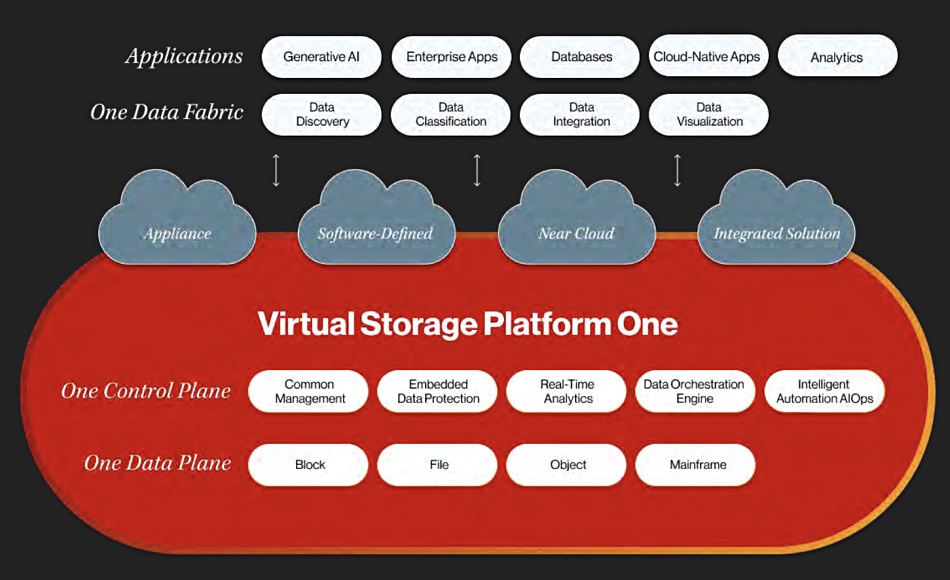Hitachi Vantara’s Virtual Storage Platform One (VSP One), a unified hybrid cloud storage product, has moved into the realm of the public cloud with AWS.
Update: SDS File and object info added. 18 April 2024.
The high-end and mid-range VSP arrays were previously built on proprietary hardware up until a few years ago, but Hitachi Vantara added software-defined features and support for commodity x86-based hardware. It then announced Virtual Storage Software Block, layered on top of SVOS and presenting a single data plane across Hitachi Vantara’s mid-range, enterprise, and software-defined storage portfolio.
Hitachi Vantara said it would eventually extend into the public cloud. In February this year, all the storage products were being brought together under a hybrid VSP (Virtual Storage Platform) One brand. VSP One running on AWS now fulfills that aim of extending into the public cloud.

Octavian Tanase, chief product officer at Hitachi Vantara, said: “Virtual Storage Platform One is transformational in the storage landscape because it unifies data and provides flexibility regardless of whether your data is in an on-premises, cloud, or software-defined environment.”
“Additionally, the platform is built with resiliency in mind, guaranteeing 100 percent data availability, modern storage assurance, and effective capacity across all its solutions, providing organizations with simplicity at scale and an unbreakable data foundation for hybrid cloud.”
There is a single control plane, data plane, and data fabric with VSP One, and three products available initially:
- Virtual Storage Platform One SDS Block
- Virtual Storage Platform One SDS Cloud – cloud-native SVOS in AWS
- Virtual Storage Platform One File
We were told by a Hitachi V spokesperson: “The Virtual Storage Platform One File is an appliance. We plan to offer SDS File in 2025.” Note that Hitachi Content Software for File is based on an OEM relationship whereas: “Virtual Storage Platform One is home to our own IP only.” Also: “Longer term we will be offering Virtual Storage Platform One Object that will integrate file services as will our block offerings. In 2025 we will be launching the Virtual Storage Platform One Community that will be the home of our OEM and 3rd party offerings to build out a data platform into a custom solution.”
Hitachi Vantara says VSP One features include:
- VSP One SDS Cloud available in the AWS Marketplace
- One data plane running across the VSP products on-premises, in colos, and in the AWS cloud
- Automate VSP One SDS Block and Cloud with Ansible playbooks available on GitHub from launch, but not File
- Cloud observability via a dashboard for the whole portfolio with Hitachi Ops Center Clear Sight
- Simplified and accelerated VSP One File has a 100 percent data availability guarantee
Dan McConnell, Hitachi Vantara SVP for product management, said in a blog late last year: “This announcement signals a major strategic direction for our company. Imagine a single data plane that spreads neatly across your organization’s structured and unstructured data, from traditional hardware optimized arrays to scalable software defined, to cloud-hosted.”
The unstructured data includes files and also objects and mainframe data, according to an eBook.

McConnell says VSP One will “be infused with Hitachi Vantara machine learning models that enable administrators to not only query and pull insights from the infrastructure but to automate and augment processes, such as determining the best deployment architecture for an application’s data.”
Additional VSP One products will be available later this year. Various links off the Hitachi Vantara VSP One web page tell you more.
Comment
Sheila Rohra’s Hitachi Vantara is catching up with Dell, HPE, and NetApp as a long-term incumbent storage supplier embracing software-defined storage, commodity hardware, unified block, file and object storage, hybrid on-premises and public cloud availability, control planes, and a cloud-like operating model. We can expect VSP One to appear in the Azure and Google clouds and to support GenAI and retrieval-augmented generation.








